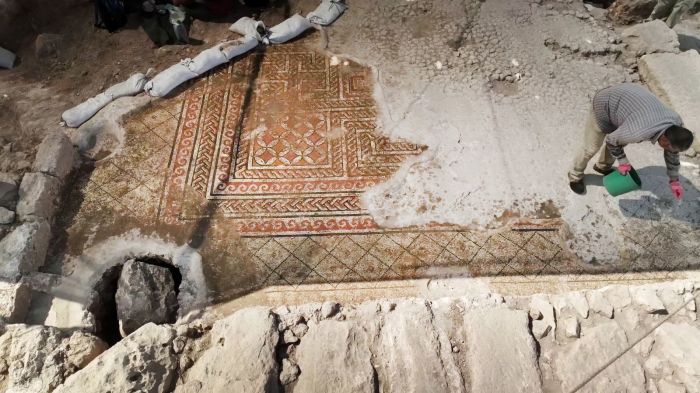
A large complex with multiple grand rooms and evidence of ancient agriculture has been uncovered in Kafr Qasim, near Petach Tikva. Archaeologists say the site is believed to be the birthplace of Menander, a Samaritan magician who succeeded Simon Magus, mentioned in chapter 8 of the Book of Acts.
The estate, identified as Samaritan and dating back some 1,600 years, was discovered by the Israel Antiquities Authority (IAA), which has been excavating the area before a new neighborhood was built at the location.
As is so often the case, those wishing to construct new buildings had sought the necessary permits and a dig was ordered to see what lay beneath the surface before building began.
The Israeli Ministry of Construction and Housing financed the salvage excavation at the site, which falls within the boundaries of the archaeological site Kafr Ḥatta, before the new foundations were laid. It was during that dig that archaeologists found multiple buildings featuring beautiful mosaics, along with well-preserved ritual baths and an olive press.
The remains of the estate were soon settled as being part of a Samaritan community which had been thriving from the time of the Romans to the Byzantines, from the fourth to the seventh centuries A.D.
“The size and splendor of the buildings discovered, the quality of their mosaic floors and the impressive agricultural installations, all point to the great wealth and prosperity of the local Samaritan community over the years,” said IAA directors Alla Nagorsky and Dr. Daniel Leahy Griswold in a press release.
The site of Kh. Kafr Ḥatta is a notable place historically, being the birthplace of Menander, who followed Simon the Magician, someone not only mentioned in the New Testament as one who responded to the Gospel but also considered to be the father of the Gnostic sects.
The Apostle Philip went to Samaria to preach and encountered the magician, who had something of a conversion experience but never quite seemed to leave his fondness for supernatural power. Acts chapter 8 describes him as a well-known individual of his day.
“There was a man named Simon, who had previously practiced magic in the city and amazed the people of Samaria, saying that he himself was somebody great. They all paid attention to him, from the least to the greatest, saying, ‘This man is the power of God that is called Great.’” (Acts 8:9-10)
The archaeological site is also being described as “magnificent” with many colorful and impressive mosaics.
One such mosaic floor was decorated with a dense geometric pattern and depictions of vegetation. It features a central medallion flanked with acanthus leaves and fruits and vegetables, including grapes, dates, watermelons, artichokes and asparagus.
In the entrance to this room was a partially preserved Greek inscription wishing the owner of the building “Good luck!” or “Mazel tov!” in Hebrew.
This greeting is an expression of congratulations in Israel today, such as a birthday greeting, but relates to luck, fate or magic. The name on the inscription is Rabia, which was common in Samaritan communities at that time.
A spacious warehouse was also found on the estate, and the elaborate olive press was discovered in close proximity to the ritual bath, or mikveh, suggesting that those involved in olive oil production had to be ritually pure.
“This type of olive press is more typical of the Jerusalem region and the Judean Shephelah and is less common in Samaria,” says Nagorsky.
The archaeologist outlined how the function of the estate changed over the years, as Byzantine restrictions were imposed following a series of Samaritan revolts in the fifth and sixth centuries: “The wealth and luxury of the buildings were replaced by oil production and agricultural installations. New walls damaged the mosaic floors, and the magnificent capitals and columns were integrated within the new walls,” Nagorsky explained.
“What makes this site particularly interesting is that unlike some of the other Samaritan sites that were destroyed in these revolts, the agricultural estate in Kafr Qasim actually continued in use, and even preserved its Samaritan identity — as evidenced by the Samaritan ceramic oil-lamps uncovered in our excavation,” she added.
“This is a fascinating site, which displays the historical gamut between the days of prosperity and the decline of the Samaritan community,” Nagorsky continued. “Its long-term existence and impressive findings will allow us to reconstruct its history over centuries and will enrich our knowledge about this population in ancient times.”
Israeli Minister of Heritage Amichai Eliyahu also expressed his keen interest in the site: “The discovery of the Samaritan agricultural estate illuminates another chapter in the common shared story of the ancient peoples of this land; foremost in this period, the Jews and the Samaritans. These two ancient communities led their lives based on the Torah and shared common roots, and also experienced similar hardships during periods of antagonistic rule.”
“The impressive findings indicate the prosperity of a community closely related to Judaism, who lived in the Land of Israel for many centuries. These physical remains are another reminder that our heritage in this land is deep and multi-faceted.”
This article was originally published by All Israel News.
ALL ISRAEL NEWS is based in Jerusalem and is a trusted source of news, analysis and information from Israel to our Christian friends around the world.

















